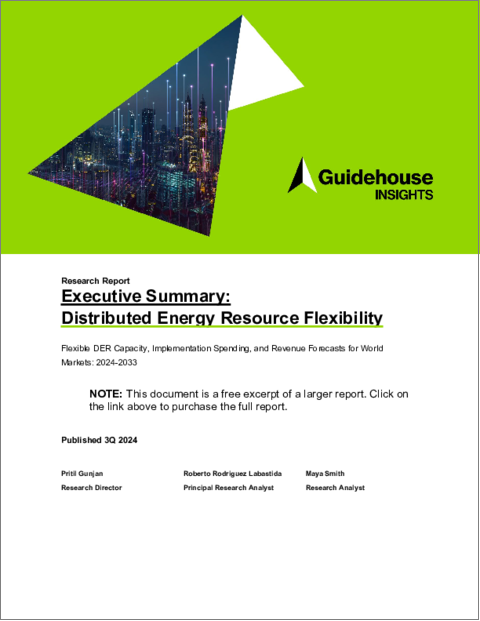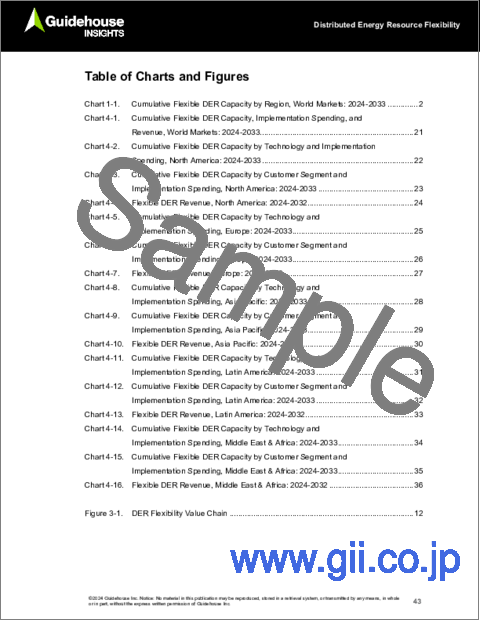|
|
市場調査レポート
商品コード
1504500
分散型エネルギー資源 (DER) の柔軟性Distributed Energy Resource Flexibility: Flexible DER Capacity, Implementation Spending, and Revenue Forecasts in World Markets, 2024-2033 |
||||||
|
|||||||
| 分散型エネルギー資源 (DER) の柔軟性 |
|
出版日: 2024年07月02日
発行: Guidehouse Research
ページ情報: 英文 47 Pages; 45 Tables, Charts & Figures
納期: 即納可能
|
全表示
- 概要
- 図表
- 目次
送電網の柔軟性は、これまでは出力調整可能な (dispatchable) 化石燃料発電所によってもたらされてきましたが、世界経済が気候変動目標を追求するようになったため、発電による炭素排出量を削減するための代替技術や方法を必要とされています。 今では、あらゆるセグメントの顧客が分散型エネルギー資源 (DER) を導入しています。DERが仮想発電所 (VPP) や従来型の需要応答 (DR) のような柔軟性プログラムに集約・登録された場合、それらは貴重なエネルギー源・発電容量・その他の電力網サービスとなり、より費用対効果が高く、よりクリーンで、より回復力のある電力網につながります。
エネルギーハードウエアおよびソフトウエアの進歩とは、電力網の運営者がDERの柔軟性獲得のために活用できる市場促進要因です。より広範な普及を阻む障壁のひとつに、旧態依然とした卸電力市場規制と電力会社の収益構造、それに顧客支援や教育の不足があります。送電網の立地に関する規制状況は、送電網の運用者がDERから柔軟性を得るための様々な方法 (卸電力市場、域内の柔軟性市場、配電レベルのプログラム) を直接利用する能力に大きく影響します。
当レポートでは、小売用・卸売用VPPと従来型DRプログラムを含む、分散型DERの市場を調査しています。2024年から2033年の予測期間について、主要5地域の発電容量、導入支出、収益に関する地域レベルの予測を示しています。容量予測は、技術の種類別 (VPPとDR) と顧客分類別 (家庭用、商業用・産業用) で区分し、収益予測はDER所有者と柔軟性サービスプロバイダーで区分しています。
目次
第1章 エグゼクティブサマリー
第2章 市場の問題
- イントロダクション
- 促進要因
- 低コストの電力網リソースの機会
- 顧客側でのDER採用の増加
- 柔軟性を実現する技術の進歩
- 抑制要因
- 時代遅れの規制と、インセンティブの不一致
- 顧客へのアウトリーチと教育
- その他のビジネス上の問題
- DERの初期費用
- 柔軟性を提供するための顧客インセンティブ
- 規制の概要
第3章 産業バリューチェーン
- イントロダクション
- 競合情勢
- 企業合併・買収 (M&A) 活動
- DER柔軟性の獲得方法
- 卸売市場への参加
- 配電ユーティリティ・プログラムと二国間契約
- 域内の柔軟性市場
- DERの柔軟性の市場規模 (金額ベース)
第4章 市場予測
- 市場予測:概要
- 前提条件と手法
- 予測上の定義
- 世界のDER柔軟性市場
- 地域別の予測
- 北米
- 欧州
- アジア太平洋
- ラテンアメリカ
- 中東・アフリカ
第5章 結論・提言
- 結論
- 3つの大きなポイント
- 推奨事項
- DERアグリゲーター
- 配電事業者 (ユーティリティ) および送電網オペレーター
- 規制当局と市場運営者
第6章 頭字語・略語一の覧
第7章 目次
第8章 図表
第9章 調査範囲、情報源・調査手法、注釈
List of Tables
- Flexible DER Capacity by Region, World Markets: 2024-2033
- Flexible DER Revenue by Region, World Markets: 2024-2033
- Flexible DER Implementation Spending by Region, World Markets: 2024-2033
- Cumulative Flexible DER Capacity by Technology, North America: 2024-2033
- Cumulative Flexible DER Capacity by Customer Segment, North America: 2024-2033
- Flexible DER Revenue, North America: 2024-2033
- Flexible DER Implementation Spending, North America: 2024-2033
- Cumulative Flexible DER Capacity by Technology, Europe: 2024-2033
- Cumulative Flexible DER Capacity by Customer Segment, Europe: 2024-2033
- Flexible DER Revenue, Europe: 2024-2033
- Flexible DER Implementation Spending, Europe: 2024-2033
- Cumulative Flexible DER Capacity by Technology, Asia Pacific: 2024-2033
- Cumulative Flexible DER Capacity by Customer Segment, Asia Pacific: 2024-2033
- Flexible DER Revenue, Asia Pacific: 2024-2033
- Flexible DER Implementation Spending, Asia Pacific: 2024-2033
- Cumulative Flexible DER Capacity by Technology, Latin America: 2024-2033
- Cumulative Flexible DER Capacity by Customer Segment, Latin America: 2024-2033
- Flexible DER Revenue, Latin America: 2024-2033
- Flexible DER Implementation Spending, Latin America: 2024-2033
- Cumulative Flexible DER Capacity by Technology, Middle East & Africa: 2024-2033
- Cumulative Flexible DER Capacity by Customer Segment, Middle East & Africa: 2024-2033
- Flexible DER Revenue, Middle East & Africa: 2024-2033
- Flexible DER Implementation Spending, Middle East & Africa: 2024-2033
DER Flexibility Regulatory Overview for Select Countries/Regions
Description of DER Flexibility Value Chain
DER Flexibility Market: Competitive Structure
Examples of Value of Flexibility
List of Figures
- Cumulative Flexible DER Capacity by Region, World Markets: 2024-2033
- Cumulative Flexible DER Capacity, Implementation Spending, and Revenue, World Markets: 2024-2033
- Cumulative Flexible DER Capacity by Technology and Implementation Spending, North America: 2024-2033
- Cumulative Flexible DER Capacity by Customer Segment and Implementation Spending, North America: 2024-2033
- Flexible DER Revenue, North America: 2024-2033
- Cumulative Flexible DER Capacity by Technology and Implementation Spending, Europe: 2024-2033
- Cumulative Flexible DER Capacity by Customer Segment and Implementation Spending, Europe: 2024-2033
- Flexible DER Revenue, Europe: 2024-2033
- Cumulative Flexible DER Capacity by Technology and Implementation Spending, Asia Pacific: 2024-2033
- Cumulative Flexible DER Capacity by Customer Segment and Implementation Spending, Asia Pacific: 2024-2033
- Flexible DER Revenue, Asia Pacific: 2024-2033
- Cumulative Flexible DER Capacity by Technology and Implementation Spending, Latin America: 2024-2033
- Cumulative Flexible DER Capacity by Customer Segment and Implementation Spending, Latin America: 2024-2033
- Flexible DER Revenue, Latin America: 2024-2033
- Cumulative Flexible DER Capacity by Technology and Implementation Spending, Middle East & Africa: 2024-2033
- Cumulative Flexible DER Capacity by Customer Segment and Implementation Spending, Middle East & Africa: 2024-2033
- Flexible DER Revenue, Middle East and Africa: 2024-2033
DER Flexibility Value Chain
Power grid flexibility has historically come from dispatchable fossil fuel power plants, but world economies in pursuit of climate goals require alternative technologies and methods to reduce emissions from power generation. Customers in all segments are installing distributed energy resources (DER). When aggregated and enrolled in flexibility programs like virtual power plants (VPPs) or traditional demand response (DR), they can be valuable sources of energy, capacity, and other grid services leading to a more cost-effective, cleaner, and resilient power grid.
Advances in energy hardware and software are market drivers that grid operators can leverage for DER flexibility. Among the barriers to more widespread adoption are antiquated wholesale electricity market regulations and utility revenue structures, along with a lack of customer outreach and education. The regulatory landscape where a grid is located heavily influences a grid operator's ability to use the various methods of achieving flexibility from DER, directly through the wholesale electricity markets, local flexibility markets, or distribution level programs.
This Guidehouse Insights report examines the flexible DER market including retail and wholesale VPPs and traditional DR programs. Regional level forecasts for capacity, implementation spending, and revenue are presented across five major geographic regions for the forecast period of 2024-2033. Capacity forecasts are segmented by technology type (VPP and DR) and customer segment (residential and commercial & industrial) while revenue forecasts are segmented by DER owner and the flexibility service provider.
Table of Contents
1. Executive Summary
- 1.1 Introduction
- 1.2 Market Issues
- 1.3 Industry Value Chain
- 1.4 Market Forecasts
2. Market Issues
- 2.1 Introduction
- 2.2 Drivers
- 2.2.1 Low Cost Grid Resource Opportunities
- 2.2.2 Increased Customer Adoption of DER
- 2.2.3 Flexibility-Enabling Technology Advances
- 2.3 Barriers
- 2.3.1 Antiquated Regulations and Mismatched Incentives
- 2.3.2 Customer Outreach and Education
- 2.4 Other Business Issues
- 2.4.1 Upfront Costs of DER
- 2.4.2 Customer Incentives for Providing Flexibility
- 2.5 Regulatory Overview
3. Industry Value Chain
- 3.1 Introduction
- 3.2 Competitive Landscape
- 3.2.1 Merger and Acquisition Activities
- 3.3 DER Flexibility Procurement Methods
- 3.3.1 Wholesale Market Participation
- 3.3.2 Distribution Utility Programs and Bilateral Contracts
- 3.3.3 Local Flexibility Markets
- 3.4 Value of DER Flexibility
4. Market Forecasts
- 4.1 Forecast Introduction
- 4.2 Assumptions and Methodology
- 4.3 Forecast Definitions
- 4.4 Global DER Flexibility Market
- 4.5 Regional Forecasts
- 4.5.1 North America
- 4.5.2 Europe
- 4.5.3 Asia Pacific
- 4.5.4 Latin America
- 4.5.5 Middle East & Africa
5. Conclusions and Recommendations
- 5.1 Conclusions
- 5.2 Three Big Takeaways
- 5.3 Recommendations
- 5.3.1 DER Aggregators
- 5.3.2 Distribution Utilities and Grid Operators
- 5.3.3 Regulators and Market Operators





